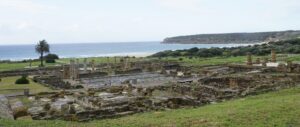On Tuesday, 7 February the weather took a turn for the worse, with rain and thunder in the forecast by late afternoon so we decided to head out towards Seville. Driving along some unmarked but mostly tarmac roads and stopping on several occasions as we left the National Park to watch the antics of storks, amongst other birds and beasts, we found a place to stop overnight just as the rainstorms arrived.
We parked up at Puerto Gelves, a Marina on the Guadalquivir River, just a few miles from the centre of Seville. There were just two places available, at €15 without electricity. We checked out the bus timetable and decided to go into Seville for supper. A 20 minute bus ride each way and we enjoyed a rather wet evening in the city, only 56 miles from El Rocío. Having done some research about where to go in the rain, we decided against Cadiz due to access issues for the van, with the alternative being a boat trip! Not ideal in the rain, so on Wednesday, we headed for the Roman archeological site at Baelo Claudia near Tarifa (the most southerly point in Europe).
After taking the motorway south from Seville we drove through the fantastic small area of the Parque Natural de la Bahía de Cádiz, then along the coast arriving at about 1700 in Bolonia, a drive of 135 miles. It seems vans are ‘tolerated’ in various parking areas, although there are height barriers to negotiate and it’s all extremely muddy, rutted and uninviting due to the rain. We eventually found a small stretch of gravel layby beside a fenced off bit of beach to park up. As the rain eased, we had a lovely walk along the beach to the protected sand dunes and back along a boardwalk in the forest.
On Thursday, 9 February we visited the huge visitor centre at Baelo Claudia in drizzly rain, just before a large, noisy, school party arrived. The Romans built the city at Bolonia in the 2nd century AD with the main industry being fish-salting as well as providing a commercial link to Africa. A by-product of the fish-salting industry was the fermented fish sauce, ‘garum’. In the third century AD an earthquake destroyed most of the city and it had been abandoned completely by the seventh century AD. The visitor centre, sadly seems quite neglected, as does the site itself, with overgrown paths and sections closed off. There’s quite extensive remains, including the forum and an amphitheatre, but it was a bit disappointing compared to sites we’ve visited elsewhere in Italy and Turkey. We left late morning, in the hope of better weather away from the coast, and headed into the foothills of the Serrania de Ronda.
















